This site uses cookies as defined in our Cookie Policy, by continuing to use this site you agree to their use.
Continue
| Arrive | Depart | ||||||
| 11th11 | SepSep | 202727 | Nice, France, embark on the Emerald Sakara | ||||
United with France only since 1860, Nice has its own history and atmosphere, which dates back 230,000 years. It was on Colline du Château (now château-less) and at the Plage des Ponchettes, in front of the Old Town, that the Greeks established a market-port in 350 BC and named it Nikaia, which would become Marseilles' chief coastal rival. The Romans established themselves a little later on the hills of Cimiez (Cemenelum), already previously occupied by Ligurians and Celts, and quickly overshadowed the waterfront port. After falling to the Saracen invasions, Nice regained power as an independent state, becoming an important port in the early Middle Ages.So cocksure did it become that in 1388, Nice, along with the hill towns behind, effectively seceded from the county of Provence, under Louis d'Anjou, and allied itself with Savoie. Thus began its liaison with the House of Savoy, and through it with Piedmont and Sardinia, it was the Comté de Nice (Nice County). This relationship lasted some 500 years, tinting the culture, architecture, and dialect in rich Italian hues.By the 19th century Nice was flourishing commercially, locked in rivalry with the neighboring shipping port of Genoa. Another source of income: the dawning of tourism, as first the English, then the Russian nobility, discovered its extraordinary climate and superb waterfront position. A parade of fine stone mansions and hotels closed into a nearly solid wall of masonry, separated from the smooth-round rocks of the beach by what was originally named Camin deis Anglés (the English Way), which of course is now the famous Promenade des Anglais. This magnificent crescent, which is seeking UNESCO recognition, is one of the noblest in France. Many of Nice's most delightful attractions—the Cours Saleya market, the Old Town streets, the Hotel Negresco, and the Palais Masséna—are on or close to this 10-km (6-mile) waterfront, making it the first stop for most visitors, while the redevelopment of Nice's port, around the other side of the Colline du Château, makes it easier for amblers who want to take in the Genoese architecture or peruse the antiques at the Puces de Nice, now part of the Promenade des 100 Antiquaires, along Quai Papacino. Nice also has the distinction of the "Family Plus" label, with free strollers, play areas, and restaurants with child-friendly activities. Your exciting journey begins in Nice on the French Riviera. Here, you’ll be transferred to your Emerald Cruises luxury yacht and embark on an enthralling discovery of the French and Italian coastlines. Please book your flight to arrive into Nice prior to 01:00 PM. | |||||||
| 12th12 | SepSep | 202727 | Marseille, France | ||||
Since being designated a European Capital of Culture for 2013, with an estimated €660 million of funding in the bargain, Marseille has been in the throes of an extraordinary transformation, with no fewer than five major new arts centers, a beautifully refurbished port, revitalized neighborhoods, and a slew of new shops and restaurants. Once the underdog, this time-burnished city is now welcoming an influx of weekend tourists who have colonized entire neighborhoods and transformed them into elegant pieds-à-terre (or should we say, mer). The second-largest city in France, Marseille is one of Europe's most vibrant destinations. Feisty and fond of broad gestures, it is also as complicated and as cosmopolitan now as it was when a band of Phoenician Greeks first sailed into the harbor that is today's Vieux Port in 600 BC. Legend has it that on that same day a local chieftain's daughter, Gyptis, needed to choose a husband, and her wandering eyes settled on the Greeks' handsome commander Protis. Her dowry brought land near the mouth of the Rhône, where the Greeks founded Massalia, the most important Continental shipping port in antiquity. The port flourished for some 500 years as a typical Greek city, enjoying the full flush of classical culture, its gods, its democratic political system, its sports and theater, and its naval prowess. Caesar changed all that, besieging the city in 49 BC and seizing most of its colonies. In 1214 Marseille was seized again, this time by Charles d'Anjou, and was later annexed to France by Henri IV in 1481, but it was not until Louis XIV took the throne that the biggest transformations of the port began; he pulled down the city walls in 1666 and expanded the port to the Rive Neuve (New Riverbank). The city was devastated by plague in 1720, losing more than half its population. By the time of the Revolution, Marseille was on the rebound once again, with industries of soap manufacturing and oil processing flourishing, encouraging a wave of immigration from Provence and Italy. With the opening of the Suez Canal in 1869, Marseille became the greatest boomtown in 19th-century Europe. With a large influx of immigrants from areas as exotic as Tangiers, the city quickly acquired the multicultural population it maintains to this day. Dating back to 600BC, Marseille is considered to be the oldest city in France. It’s been an important trading port since ancient times, creating the rich cultural melting pot that is modern Marseille. Incredible cuisine, buzzy cafes, chic wine bars and street murals have transformed this gritty urban hub into one of France’s most exciting destinations. This eclectic city boasts a bold arts scene: visit the Musée d'Histoire de Marseille and glimpse exhibits from the city's past, or Musée d'Art Contemporain for more modern pieces. With its blend of African and French influences, Marseille has a vibrant music scene and is the birthplace of French hip hop. | |||||||
| 13th13 | SepSep | 202727 | Cannes, France | ||||
Cannes is pampered with the luxurious year-round climate that has made it one of the most popular resorts in Europe. Cannes was an important sentinel site for the monks who established themselves on Île St-Honorat in the Middle Ages. Its bay served as nothing more than a fishing port until in 1834 an English aristocrat, Lord Brougham, fell in love with the site during an emergency stopover with a sick daughter. He had a home built here and returned every winter for a sun cure—a ritual quickly picked up by his peers. Between the popularity of Le Train Blue transporting wealthy passengers from Calais, and the introduction in 1936 of France's first paid holidays, Cannes became the destination, a tasteful and expensive breeding ground for the upper-upscale.Cannes has been further glamorized by the ongoing success of its annual film festival, as famous as Hollywood's Academy Awards. About the closest many of us will get to feeling like a film star is a stroll here along La Croisette, the iconic promenade that gracefully curves the wave-washed sand coastline, peppered with chic restaurants and prestigious private beaches. This is precisely the sort of place for which the French invented the verb flâner (to dawdle, saunter): strewn with palm trees and poseurs, its fancy boutiques and status-symbol grand hotels—including the Carlton, the legendary backdrop to Grace Kelly in To Catch a Thief —all vying for the custom of the Louis Vuitton set. This legend is, to many, the heart and soul of the Côte d'Azur. Continue along the Côte d'Azur to Cannes, a name synonymous with glamour and celebrity. This lively city is known for its luxurious designer boutiques, gastronomic restaurants and upscale hotels, which are frequented by the rich and famous. The pretty beaches are lined with striped sun loungers looking out over sparkling blue ocean. It is universally famous for the Cannes Film Festival, an annual event which has become the most prestigious film festival in the world. | |||||||
| 14th14 | SepSep | 202727 | Bonifacio, Corsica, France | ||||
Located in the South of Corsica, Bonifacio is one of the island’s most beautiful destinations. From its breathtaking views and sandy white islands to its historic citadel, the city is a must visit for anyone travelling to the island. Perched atop a narrow limestone peninsula on the French Island of Corsica, Bonifacio has breathtaking views of the sparkling Mediterranean Sea. Take a step back in time, exploring Bonifacio’s atmospheric Old Town, a fortified medieval citadel filled with quaint narrow streets and historic structures. Don’t miss The Staircase of the King of Aragon (Escalier du Roi d'Aragon), a steep flight of steps carved into the cliffside, which leads down to the clear, blue-green sea. | |||||||
| 15th15 | SepSep | 202727 | Porto Cervo, Italy | ||||
Part of Sardinia’s Costa Smeralda, Porto Cervo is a luxurious resort town that blends Italian, Spanish, Greek and North African influences. It’s popular with upscale travellers who are drawn to its glamorous hotels, designer boutiques, exceptional restaurants and vibrant nightlife. Porto Cervo's marina is packed with opulent yachts and is the host of prestigious sailing events such as the Maxi Yacht Rolex Cup. Despite its reputation for luxury, Porto Cervo hasn’t lost its unmistakable Sardinian charm and is surrounded by jaw-dropping natural beauty. | |||||||
| 16th16 | SepSep | 202727 | Civitavecchia, Italy | ||||
Italy's vibrant capital lives in the present, but no other city on earth evokes its past so powerfully. For over 2,500 years, emperors, popes, artists, and common citizens have left their mark here. Archaeological remains from ancient Rome, art-stuffed churches, and the treasures of Vatican City vie for your attention, but Rome is also a wonderful place to practice the Italian-perfected il dolce far niente, the sweet art of idleness. Your most memorable experiences may include sitting at a caffè in the Campo de' Fiori or strolling in a beguiling piazza. One of the busiest ports in the Mediterranean, Civitavecchia is often called the Port of Rome and is the gateway to the ancient Italian capital. It was founded in the second century AD and remnants of the ancient Roman port are still evident today. Once in the Eternal City, there are iconic landmarks and millennia-old ruins at every turn. Visit the Colosseum, Roman Forum, Pantheon, Trevi Fountain and Vatican City, or just relax in a cobbled square with an authentic pizza and a glass of wine. | |||||||
| 17th17 | SepSep | 202727 | Bastia, France | ||||
Corsica's northern capital, Bastia, is the centre of commerce and industry and a thriving freight and passenger port. Commerce, more than tourism, is its main focus, providing employment for many Corsicans. Bastia's industrial sprawl, however, is offset by its aged charm. The presence of an overwhelming Italian atmosphere adds to the city's attraction. Two distinct areas comprise the city: Terra Vecchia, the old quarter, consisting of haphazard streets, flamboyant Baroque churches and lofty tenements, with their crumbling golden-grey walls set against a backdrop of fire-darkened hills; and the more orderly Terra Nova, the historic district favoured by prominent doctors, lawyers and architects. The city dates from Roman times, when a base was set up at Biguglia to the south. Under the Genoese, Bastia was the island's capital for four centuries and of major importance for the export of wine to the Italian mainland. They built a fortress (bastiglia), which gave the town its name. The Genoese also were responsible for laying the foundation for the area's prosperity by planting vines, olives, chestnut trees and other experimental crops. This resulted in an energetic and enterprising region, still a characteristic of today's northern Corsica. Although Napoleon had appointed Ajaccio the capital of the island in 1811- initiating a rivalry that still exists - Bastia established a stronger trading position with mainland France. As a result, the Nouveau Port was created in 1862 to cope with the increasing traffic with France and Italy. Bastia's economic prominence and a German division based here during World War II accounted for severe bombing attacks. Many buildings were destroyed, including much of the old governor's palace. Of the two largest towns on the island, Ajaccio and Bastia, the latter boasts a more genuine Corsican character. Visitors can experience an authentic feel of island life by wandering through the maze of narrow streets of Bastia's old quarter and by exploring its fortifications. Don't miss the vast Place Saint-Nicolas just north of the old quarter; it is the focal point of the city. Open to the sea and lined with shady trees and sidewalk cafes, it is a perfect place for people watching and for taking in the local ambiance. Pier Information The ship is scheduled to dock at the port of Bastia. The city's focal point, Place Saint-Nicolas, is a distance of 650 feet (200 metres) to walk. Taxis are generally available at the pier but it is highly recommended to book in advance if you want to be sure to get one. It is recommended to establish the fare before leaving the port. Shopping The main shopping streets, Boulevard Paoli and Rue Cesar Campinchi, are less than one half miles (500 metres) from the port terminal. Handicrafts and the area's specialties such as honey, wine and liqueurs may be of interest. Most shops are open from 9:00 a.m. to 12:00 p.m. and 2:30 p.m. to 7:00 p.m. Shops are closed for the day on Sundays and some shops may also close Monday mornings (some souvenirs shops may open Sundays during the high season of July-August). The local currency is the euro. Cuisine A variety of restaurants offer a good choice of eating possibilities. Some of the best restaurants are found around the Vieux Port and on the Quai des Martyrs. French cuisine and seafood feature prominently on menus as well as such Corsican specialties as wild boar, charcuterie and aziminu, a local version of bouillabaisse. Evidence of Bastia's strong Italian influence is apparent in the numerous pizza and pasta places in the Nouveau Port area. For outdoor dining and people watching, cafes around lively Place Saint-Nicolas are a perfect place. Other Sites Oratoire de Saint-Roch Located in the Terra Vecchia quarter, the chapel is a Genoese Baroque extravaganza built in 1604. The walls are covered with finely carved wooden panelling and the organ is magnificent with its decoration of gilt and wooden sculpture. Oratoire de L'Immaculee Conception Although its exterior is rather austere, the flamboyant interior of this 17th-century church with gilt and marble ceiling, frescoes and crystal chandeliers creates an ambiance of an opera house. Vieux Port Site of the original Porto Prado, the area around the Vieux Port is the most appealing part of town. Its soaring houses seem to bend inwards towards the water. Once busy with Genoese traders, the building of the ferry terminal and commercial docks have reduced much of the action at Vieux Port. Terra Nova As the administrative core of old Bastia, Terra Nova displays a distinct air of affluence. Its most impressive building is the 14th-century Governor's Palace. During the Genoese heyday the governor and the bishop lived here, entertaining foreign dignitaries and hosting massive parties. Private arrangements for independent sightseeing may be requested through the Tour Office on board, subject to the availability of English-speaking guides. Return to the beautiful island of Corsica, but this time dock on its northern shores and the bustling port of Bastia. The second busiest port in France after Calaid, this is where ferries connect the island to Italy and mainland France. Though popular with tourists, Bastia retains the feel of an authentic lived-in city, giving you a true taste of life in Corsica. Bastia is also regarded as a foodie destination with numerous restaurants and markets serving authentic Corsican cuisine. Seafood is a menu mainstay, with delicious local specialties such as aziminu, a type of fish bouillabaisse made with rockfish. | |||||||
| 18th18 | SepSep | 202727 | Nice, France | ||||
United with France only since 1860, Nice has its own history and atmosphere, which dates back 230,000 years. It was on Colline du Château (now château-less) and at the Plage des Ponchettes, in front of the Old Town, that the Greeks established a market-port in 350 BC and named it Nikaia, which would become Marseilles' chief coastal rival. The Romans established themselves a little later on the hills of Cimiez (Cemenelum), already previously occupied by Ligurians and Celts, and quickly overshadowed the waterfront port. After falling to the Saracen invasions, Nice regained power as an independent state, becoming an important port in the early Middle Ages.So cocksure did it become that in 1388, Nice, along with the hill towns behind, effectively seceded from the county of Provence, under Louis d'Anjou, and allied itself with Savoie. Thus began its liaison with the House of Savoy, and through it with Piedmont and Sardinia, it was the Comté de Nice (Nice County). This relationship lasted some 500 years, tinting the culture, architecture, and dialect in rich Italian hues.By the 19th century Nice was flourishing commercially, locked in rivalry with the neighboring shipping port of Genoa. Another source of income: the dawning of tourism, as first the English, then the Russian nobility, discovered its extraordinary climate and superb waterfront position. A parade of fine stone mansions and hotels closed into a nearly solid wall of masonry, separated from the smooth-round rocks of the beach by what was originally named Camin deis Anglés (the English Way), which of course is now the famous Promenade des Anglais. This magnificent crescent, which is seeking UNESCO recognition, is one of the noblest in France. Many of Nice's most delightful attractions—the Cours Saleya market, the Old Town streets, the Hotel Negresco, and the Palais Masséna—are on or close to this 10-km (6-mile) waterfront, making it the first stop for most visitors, while the redevelopment of Nice's port, around the other side of the Colline du Château, makes it easier for amblers who want to take in the Genoese architecture or peruse the antiques at the Puces de Nice, now part of the Promenade des 100 Antiquaires, along Quai Papacino. Nice also has the distinction of the "Family Plus" label, with free strollers, play areas, and restaurants with child-friendly activities. This morning, after breakfast, you can set off to explore Nice at leisure. In this charming port city, strolling along its alluring Promenade des Anglais, discover discovering the delightful charming old quarter old town, and soaking up in the glamorous vibrant atmosphere of the French Riviera. In the afternoon, you’ll be welcomed back on board your Emerald Cruises luxury yacht for the second half of your journey, ready to explore more of the wondrous Mediterranean shores. | |||||||
| 19th19 | SepSep | 202727 | Santa Margherita Ligure, Italy | ||||
Welcome to Santa Margherita Ligure, a charming resort town with panoramic views that’s revered for its timeless elegance and style. For those seeking ‘la dolce vita,’ you’re sure to find it in abundance here. Stroll the Santa Margherita promenade or the pebbly beachfront, admiring the gleaming yachts and sailing boats. Marvel at an impressive Baroque-era church along the cobbled streets and savour succulent red shrimps, the local fishermen’s catch of the day. Later in the morning, you’ll sail on to delightful Portofino. Embedded along the Italian Riviera, eternally popular Portofino boasts a rich gastronomic scene, a picturesque harbour and narrow streets lined with charming, pastel-hued houses, high-end boutiques and restaurants specialising in freshly caught seafood. | |||||||
| 19th19 | SepSep | 202727 | Portofino, Italy | ||||
One of the most photographed villages along the coast, with a decidedly romantic and affluent aura, Portofino has long been a popular destination for the rich and famous. Once an ancient Roman colony and taken by the Republic of Genoa in 1229, it’s also been ruled by the French, English, Spanish, and Austrians, as well as by marauding bands of 16th-century pirates. Elite British tourists first flocked to the lush harbor in the mid-1800s. Some of Europe's wealthiest drop anchor in Portofino in summer, but they stay out of sight by day, appearing in the evening after buses and boats have carried off the day-trippers.There's not actually much to do in Portofino other than stroll around the wee harbor, see the castle, walk to Punta del Capo, browse at the pricey boutiques, and sip a coffee while people-watching. However, weaving through picture-perfect cliffside gardens and gazing at yachts framed by the sapphire Ligurian Sea and the cliffs of Santa Margherita can make for quite a relaxing afternoon. There are also several tame, photo-friendly hikes into the hills to nearby villages.Unless you're traveling on a deluxe budget, you may want to stay in Camogli or Santa Margherita Ligure rather than at one of Portofino's few very expensive hotels. Restaurants and cafés are good but also pricey (don't expect to have a beer here for much under €10). | |||||||
| 20th20 | SepSep | 202727 | Portovenere, Italy | ||||
The colorful facades and pedestrians-only calata (promenade) make Portovenere the quintessential Ligurian seaside village. As a UNESCO World Heritage Site, its harbor is lined with tall, thin "terratetto" houses that date from as far back as the 11th century and are connected in a wall-like formation to protect against attacks by the Pisans and local pirates. Its tiny, carruggi (alley-like passageways) lead to an array of charming shops, homes, and gardens and eventually to the village's impressive Castle Doria high on the olive tree covered hill. To the west standing guard over the Mediterranean is the picturesque medieval Chiesa di San Pietro, once the site of a temple to Venus (Venere in Italian), from which Portovenere gets its name. Nearby, in a rocky area leading to the sea, is Byron's Cave, a favorite spot that the poet loved to swim out into the sea from. Situated along the Ligurian coast on Italy’s northwest shores, Porto Venere is an ancient city dating back to the first century BC. Now a UNESCO World Heritage Site, it’s imbued with a romantic history – thanks to its penchant for attracting famous poets and artists over the centuries. Porto Venere’s wonderful swimming spots were beloved by, amongst others, the legendary English poet Lord Byron, who regularly bathed and meditated here in the early 1800s. One of Porto Venere's most striking features is its Gothic-style Church of St. Peter, dating back to the 12th century and resting atop a rocky headland overlooking the sparkling sea. | |||||||
| 21st21 | SepSep | 202727 | Calvi, Corsica, France | ||||
Calvi, Corsica's slice of the Riviera, has been described by author Dorothy Carrington as "an oasis of pleasure on an otherwise austere island." Calvi prospered by supplying products to Genoa; its citizens remained loyal supporters of Genoa long after the rest of the island declared independence. Calvi also claims to be the birthplace of Christopher Columbus. During the 18th century the town endured assaults from Corsican nationalists, including celebrated patriot Pasquale Paoli. Today Calvi sees a summertime invasion of tourists, drawn to the 6-km (4-mile) stretch of sandy white beach, impressive citadel overlooking the Old Town, lively restaurants, and buzzing nightlife. Today, you’ll arrive in Calvi, on the northwest shore of the French Island of Corsica. According to local legend, Calvi is where the 15th century Italian explorer Christopher Columbus was born. While historians may debate this, the natural beauty and rich culture of Calvi is undisputed. Calvi's gorgeous beach presents a crescent-shaped bay of powdery white sand fringed by maritime pines. The town has evolved to become Corsica’s ‘culture capital,’ hosting several music festivals over the idyllic summer months. | |||||||
| 22nd22 | SepSep | 202727 | Saint-Tropez, France | ||||
At first glance, it really doesn't look all that impressive. There's a pretty port with cafés charging €5 for a coffee and a picturesque old town in sugared-almond hues, but there are many prettier in the hills nearby. There are sandy beaches, rare enough on the Riviera, and old-fashioned squares with plane trees and pétanque players, but these are a dime a dozen throughout Provence. So what made St-Tropez an internationally known locale? Two words: Brigitte Bardot. When this pulpeuse (voluptuous) teenager showed up in St-Tropez on the arm of Roger Vadim in 1956 to film And God Created Woman, the heads of the world snapped around. Neither the gentle descriptions of writer Guy de Maupassant (1850–93), nor the watercolor tones of Impressionist Paul Signac (1863–1935), nor the stream of painters who followed (including Matisse and Bonnard) could focus the world's attention on this seaside hamlet as did this one sensual woman in a scarf, Ray-Bans, and capris. Vanity Fair ran a big article, "Saint Tropez Babylon," detailing the over-the-top petrodollar parties, megayachts, and Beyoncé–d paparazzi. But don't be turned off: the next year, Stewart, Tabori & Chang released an elegant coffee-table book, Houses of St-Tropez, packed with photos of supremely tasteful and pretty residences, many occupied by fashion designers, artists, and writers. Once a hangout for Colette, Anaïs Nin, and Françoise Sagan, the town still earns its old moniker, the "Montparnasse of the Mediterranean." Yet you might be surprised to find that this byword for billionaires is so small and insulated. The lack of train service, casinos, and chain hotels keeps it that way. Yet fame, in a sense, came too fast for St-Trop. Unlike the chic resorts farther east, it didn't have the decades-old reputation of the sort that would attract visitors all year around. For a good reason: its location on the south side of the gulf puts it at the mercy of the terrible mistral winter winds. So, in summer the crowds descend and the prices rise into the stratosphere. In July and August, you must be carefree about the sordid matter of cash. After all, at the most Dionysian nightclub in town, a glass of tap water goes for $37 and when the mojo really gets going, billionaires think nothing of "champagne-spraying" the partying crowds—think World Series celebrations but with $1,000 bottles of Roederer Cristal instead of Gatorade. Complaining about summer crowds, overpricing, and lack of customer service has become a tourist sport and yet this is what makes St-Tropez—described by the French daily newspaper Le Figaro as the place you can see "the greatest number of faces per square meter"—as intriguing as it is seductive. A shining jewel of the Côte d’Azur, the legendary resort town of Saint-Tropez is one of the most famous holiday destinations in Europe. It has been drawing celebrities and royalty since the 1950s . look out over the superyachts jostling for space in the marina, a sure sign that the international jet set is in town. From the soft white sand lapped by clear blue water to the on-trend beach clubs, decadent dining and luxury boutiques, Saint-Tropez is the ultimate French Riviera experience. For history buffs, learn the story of Saint-Tropez at the Musée d'Histoire Maritime, or peruse the incredible modern art inside a former chapel at the Annonciade. | |||||||
| 23rd23 | SepSep | 202727 | Sanary-sur-Mer, France | ||||
Continuing along the Côte d'Azur, arrive today in Sanary-sur-Mer. This classic Provençal port town still has colourful wooden fishing boats bobbing in the harbour and, pastel houses lining the shore. It’s famous for its bustling daily market in the town centre, which has been named the most beautiful in France. Walk through the stalls to see fresh produce, just-caught seafood and roasting chickens, then sample a ‘cade’, a traditional wood-fired pancake that has been a popular snack here for more than 200 years. | |||||||
| 24th24 | SepSep | 202727 | Roses, Spain | ||||
The Costa Brava (meaning the Rugged Coast) is arguably the most beautiful of Spain’s three holiday coasts. The seaside village of Roses sits on its northern edge, close to the border with France, making for a captivating blend of cultures set within a stunning setting where the mountains meet the sea., Roses began as a fishing village and is still the place to sample exceptional fresh seafood. Be sure to try the local seafood speciality of ‘Suquet de Peix’, a hearty fish soup prepared with the catch of the day along with garlic, tomatoes and saffron. | |||||||
| 25th25 | SepSep | 202727 | Barcelona, Spain, disembark the Emerald Sakara | ||||
The infinite variety of street life, the nooks and crannies of the medieval Barri Gòtic, the ceramic tile and stained glass of Art Nouveau facades, the art and music, the throb of street life, the food (ah, the food!)—one way or another, Barcelona will find a way to get your full attention. The capital of Catalonia is a banquet for the senses, with its beguiling mix of ancient and modern architecture, tempting cafés and markets, and sun-drenched Mediterranean beaches. A stroll along La Rambla and through waterfront Barceloneta, as well as a tour of Gaudí's majestic Sagrada Famíliaand his other unique creations, are part of a visit to Spain's second-largest city. Modern art museums and chic shops call for attention, too. Barcelona's vibe stays lively well into the night, when you can linger over regional wine and cuisine at buzzing tapas bars. Your luxurious yacht cruise concludes in Catalonia’s cosmopolitan capital, Barcelona, where you’ll be transferred to the airport for your return flight home or to continue your travels. Please book your flight to depart out of Barcelona after 01:00 PM. The itinerary is a guide only and may be amended for operational reasons. As such Emerald Cruises cannot guarantee the cruise will be operated unaltered from the itinerary states above. | |||||||
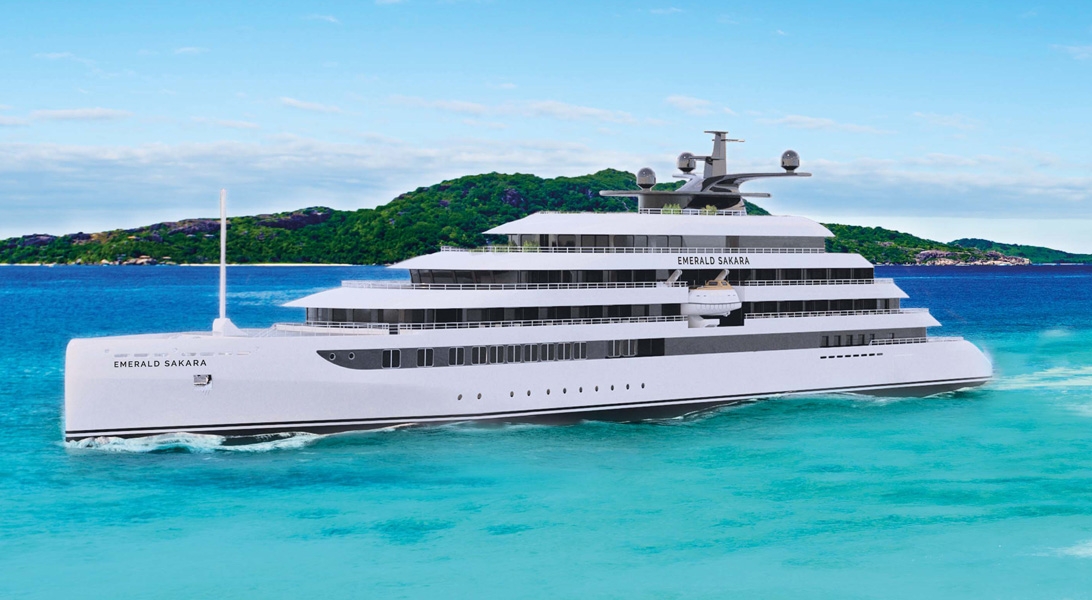
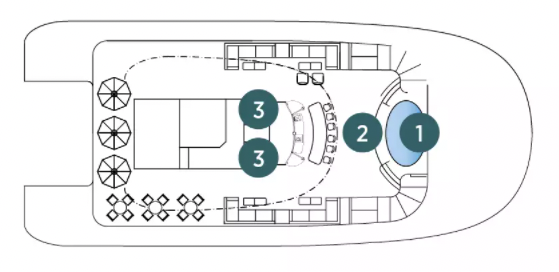





The images shown are for illustration purposes only and may not be an exact representation of what you find on the ship.
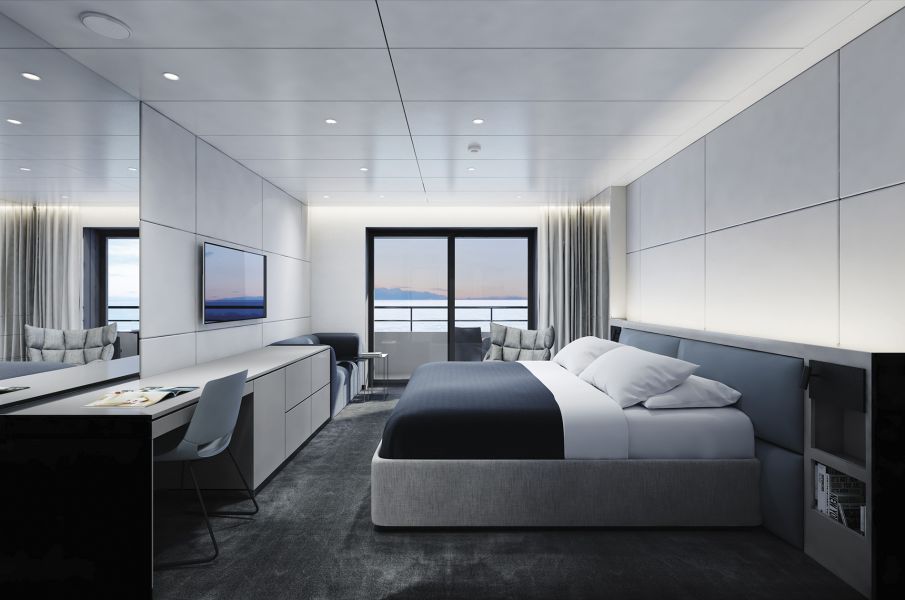
Divided between the Observation and Panorama decks, our Balcony Suites are your stylish home-away-from-home.
Featuring everything you’d expect from a world-class hotel, each one includes your own private balcony, from which to enjoy the stunning panoramas.
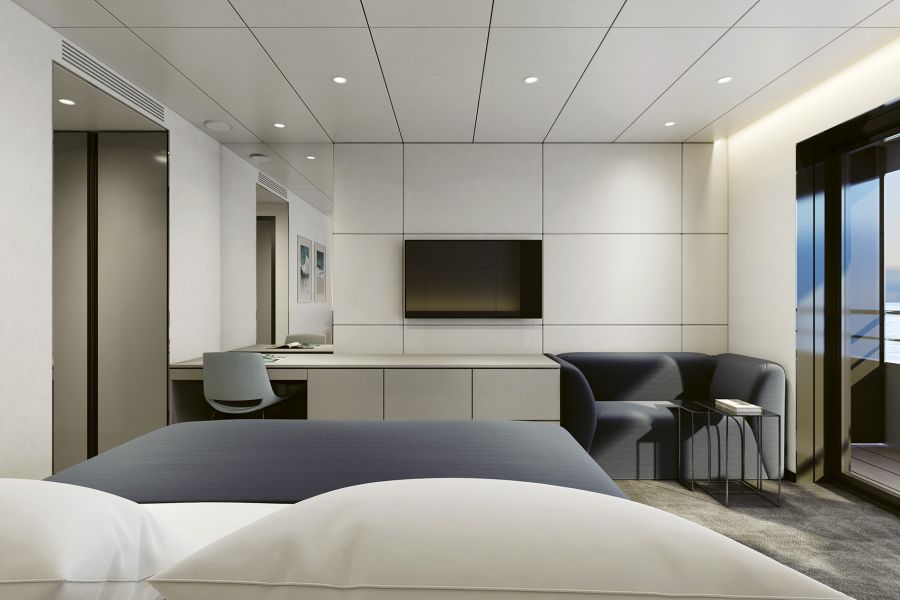
Situated on the Pool Deck, our two Deluxe Balcony Suites boast more space for your comfort.
Along with a private balcony, additional inclusions consist of coffee and tea-making facilities and a pillow menu for the perfect night’s sleep.
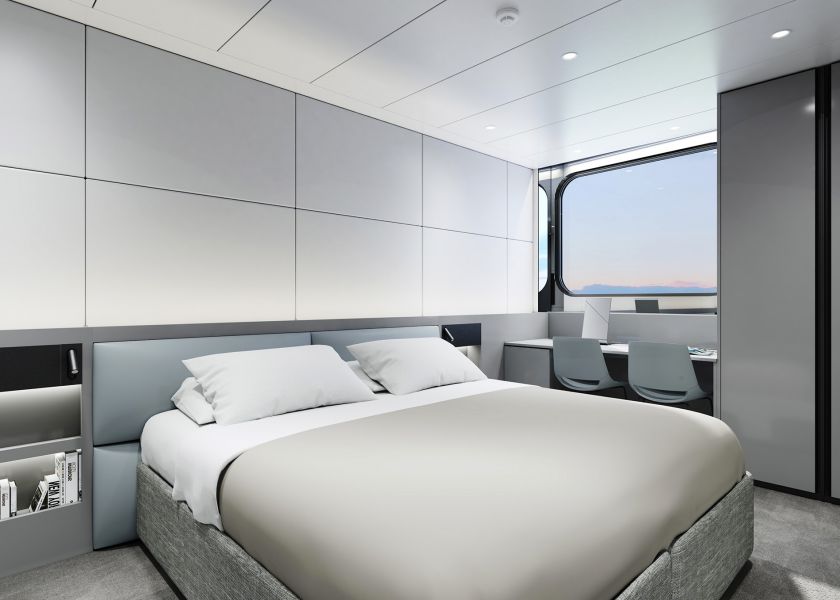
You’ll find six of our superb value Oceanview Staterooms on the Emerald Deck, situated towards the front of the yacht, each with their own ocean-view window.
Instantly settle in with our selection of included modern amenities and make the most of your close proximity to the Horizon Bar & Lounge.
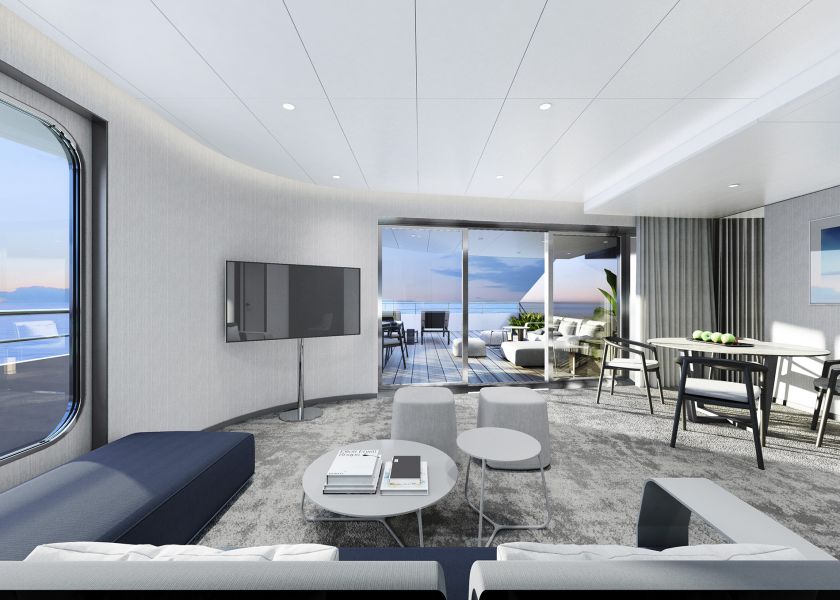
You’ll find our largest and most prestigious suites at the front of the Pool Deck, promising truly exceptional views of the unfolding landscapes.
A separate bedroom and lounge area gives you more room to roam, while a walk-in wardrobe and large private terrace encourage you to really settle into your boutique Owner's Suite.
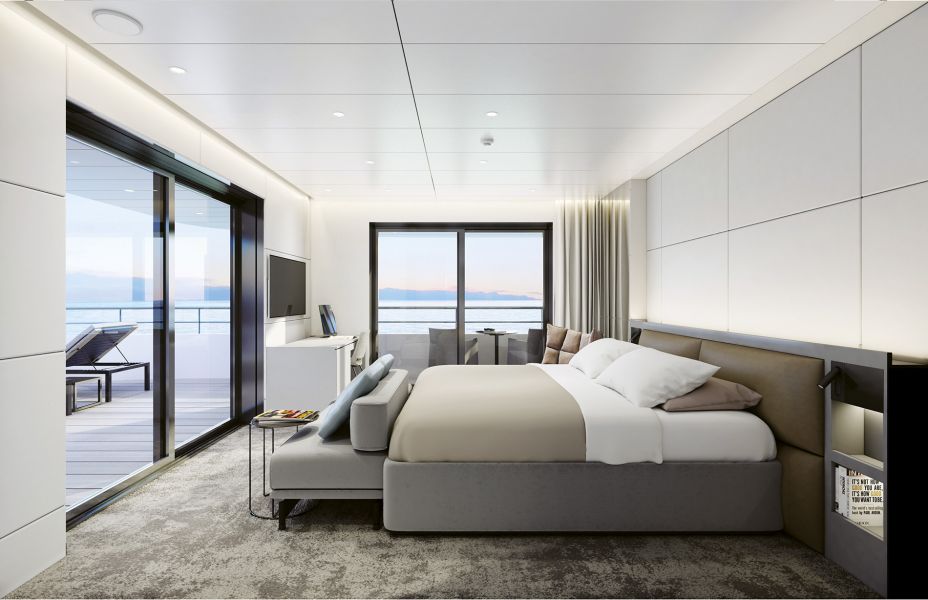
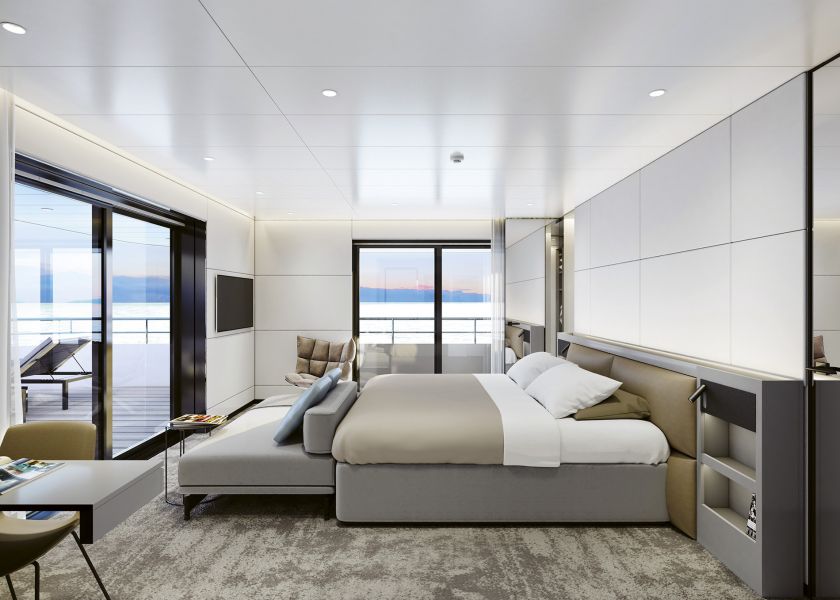
Wonderfully positioned at the back of the Observation Deck, you’ll be treated to sensational ocean and coastal views from your large private terrace.
Toast to your arrival with a complimentary bottle of champagne and a decadent fruit platter which will be waiting for you.
The images shown are for illustration purposes only and may not be an exact representation of what you find on the ship.
The images shown are for illustration purposes only and may not be an exact representation of what you find on the ship.
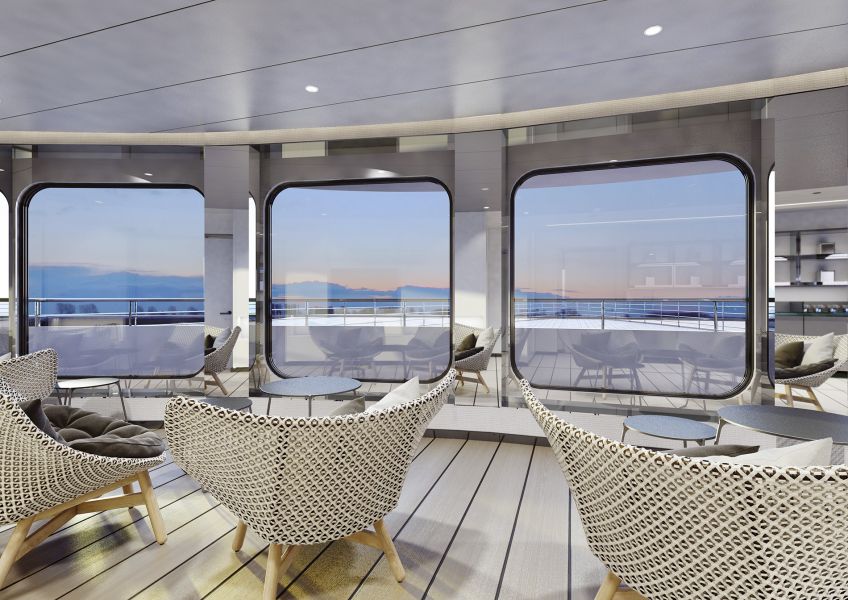
Head to the Observation Deck area for spectacular views or a morning yoga session. In the Observation Lounge, sit back and relax with a good book or play a game of chess.
The images shown are for illustration purposes only and may not be an exact representation of what you find on the ship.
The images shown are for illustration purposes only and may not be an exact representation of what you find on the ship.
| 14 nights aboard the Emerald Sakara | |||
| Return airport transfers | |||
| Wine, beer & soft drinks with lunch & dinner | |||
| Gratuities Included | |||
| One complimentary shore excursion in every port | |||
| Bikes for passenger use | |||
| Free Wi-Fi included | |||
| Port Taxes and Fees | |||
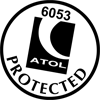 | ABTA and ATOL Protection* | ||
Date 11th Sep 2027 |
Nts 14 |
Please Call for Availability |
Date 11th Sep 2027 |
Nts 14 |
Please Call for Availability |
Fusion Cruises when selling travel arrangements is a trading name of The Midcounties Co-operative Ltd. Fusion Cruises is an Accredited Body Member of Midcounties Co-operative Travel Consortium. (ABTA:P6652, ATOL:6053).
Book with Confidence. We are a Member of ABTA which means you have the benefit of ABTA’s assistance and Code of Conduct.
Some of the flights and flight-inclusive holidays on this website are financially protected by the ATOL scheme but ATOL protection does not apply to all holiday and travel services offered on this website. This website will provide you with information on the protection that applies in the case of each holiday and travel service offered before you make your booking. If you do not receive an ATOL Certificate then the booking will not be ATOL protected. If you do receive an ATOL Certificate but all parts of your trip are not listed on it, those parts will not be ATOL protected. Please see our booking conditions for information, or for more information about financial protection and the ATOL Certificate go to: www.caa.co.uk
